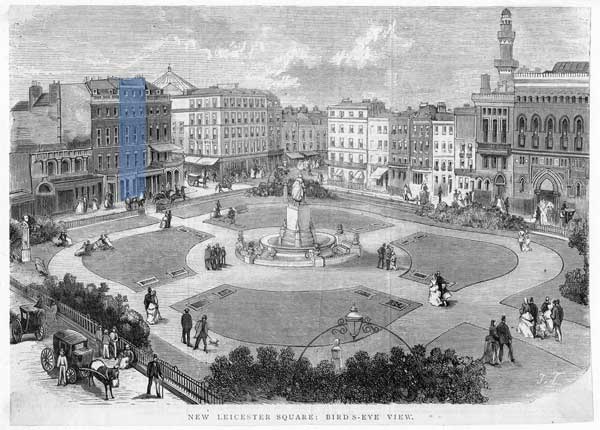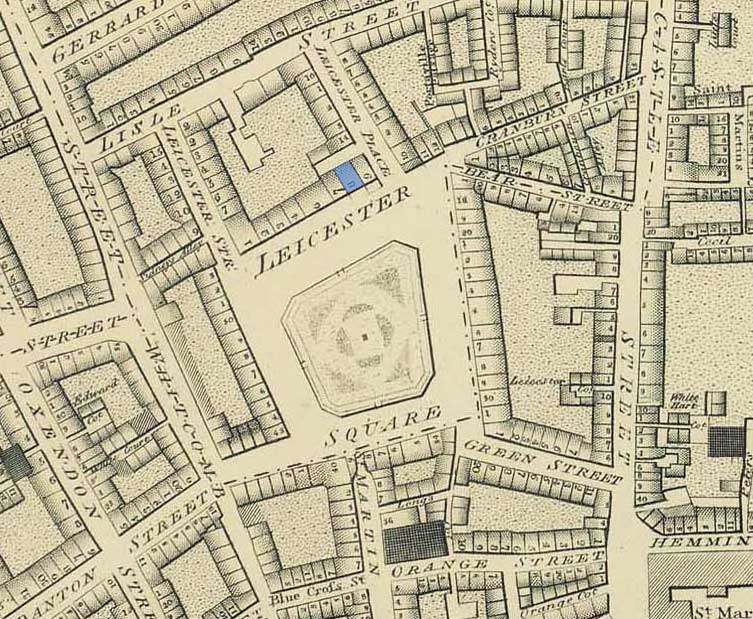8 Leicester Square, home of Francis Hammond, staymaker
Also see: Identifying Francis Hammond's House at Leicester Square
British History Online - LEICESTER SQUARE AND ITS NEIGHBOURHOOD - CHAPTER XXIII.
Walter Thornbury
1878
Leicester Square', Old and New London: Volume 3 (1878), pp. 160-173

Leicester Square in 1874

Results of Google Search 'history of leicester square' returns a rich source worthy of further investigation:
http://www.british-history.ac.uk/report.aspx?compid=41119
Survey of London: volumes 33 and 34
Author
F. H. W. Sheppard (General Editor)
Year published
1966
CHAPTER XVIII
Leicester Square, North Side, and Lisle Street Area: Leicester Estate
http://www.british-history.ac.uk/report.aspx?compid=41120#s15
describes 7-8 Leicester Square
Nos. 7–9 (consec.) Leicester Square: Queen's House
This site formed part of the curtilage of Leicester House and incorporated some of the shops which stood in front of the house (see page 454). At the sale of Elizabeth Perry's estate in November 1789 it was bought (as lot 1) by George Lempriere, who was probably a business associate of James Stuart Tulk (II). (ref. 130) Lot 1 formed part of the site of the intended opera house, and after the collapse of this venture, it and other adjoining ground was sold to Thomas Wright of Henrietta Street, Covent Garden, esquire, (ref. 175) who redeveloped much of his estate between 1792 and 1795 (see page 458).
On 19 January 1795 Wright granted three leases of the three new houses and shops at Nos. 7–9 (Plate 51a) (Refer to Printed book) to William Brooks, mason. (ref. 276) The houses backed on to Duncan Place, a short cul-de-sac leading off the west side of Leicester Place which has now been built upon. The premises continued to be used for the most part as shops until 1869, when No. 9 became the Hôtel de Paris et de l'Europe. (ref. 194) In 1856 Seale, Low and Company, bankers, added No. 7 to their premises in Leicester Place and rebuilt the latter in the 'Early Decorated style' to the designs of John Billing. (ref. 277) They remained at No. 7 until 1870. (ref. 194) Both Nos. 7 and 8 were later taken over by the hotel and the whole site redeveloped. (ref. 194) The present building bears the date 1897, and was designed by Messrs. Saville and Martin. It was originally known as the Queen's Hotel, and opened in 1899. (ref. 278) In 1936 the upper floors were converted to office use, and the Monseigneur News Theatre was constructed on part of the ground floor. (ref. 279) The building, which is now called Queen's House, has an elaborately composed and floridly ornamented exterior, stylistically classifiable as early French Renaissance. It is built of Portland stone, now painted, with polished red granite shafts to the numerous columns that are introduced in all storeys but the fourth. The ground storey of the Leicester Square front, arcaded and dressed with a Corinthian order, projects from the main face of four storeys, where polygonal buttresses form three divisions. Each side division contains a splaysided bay window feature, rising through three storeys, and finishes with a two-storeyed gable. The middle division has a first-floor bay window set in an arched recess, and above the colonnaded fourth storey is a scroll-pedimented dormer. Out of the high French roof rises a hexagonal cupola, flanked by ornate chimney-stacks. The gabled return face to Leicester Place combines features from the three divisions of the main front, but the rest of this elevation is more simply designed.
When first opened as a hotel, the ground floor contained a buffet and the grand dining-hall, the latter richly decorated with marble pilasters, paintings on walls and ceiling, and an onyx balustrade to the musicians' gallery. Downstairs was the grill-room, and on the first floor, besides a suite of masonic rooms, were drawing-, readingand coffee-rooms, decorated in the Louis XV, Empire and Louis XVI styles respectively. The upper floors contained nearly a hundred bedrooms and private sitting-rooms. (ref. 280)
Victory House is now on the other side of Leicester Place (Previously 10-12 Leicester Square)
|